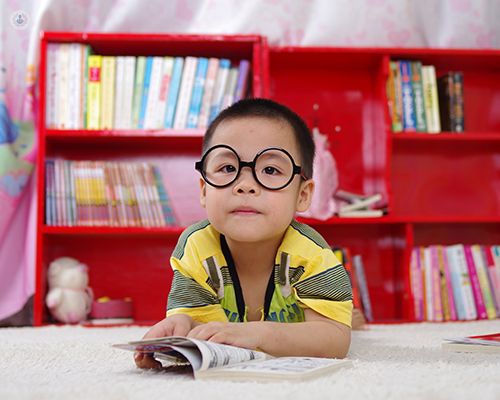What to expect from a children’s eye exam
Escrito por:Your child's health is precious and so is their eyesight. As they're getting to know colours, shapes and everything that surrounds them, it's good to make sure their eyes are performing at their best, to help them discover the world. That's why it is so important to get into the routine of regular eye exams. In his latest online article, senior consultant optometrist Mr Shakeel Puri offers explains what parents can expect at their child’s eye test.

What happens during a children’s eye test?
Children's eye tests are tailored to their unique needs. Though procedures may vary, a standard child's eye test typically includes:
Pupil reflex test (Mainly for early years):
This test is primarily conducted for babies. The clinician will shine a light into your baby’s eyes to observe how their pupils react to the light. It helps assess the functionality of the pupils and their response to changes in light intensity.
Snellen and LogMAR charts:
These charts are commonly used for vision testing. While adults read letters on Snellen charts, children may not be at the stage of reading letters yet. Instead, they’ll be shown easily recognisable pictures or symbols (such as a bunny, flower, or house). The child is asked to identify what they see on the chart.
Using pictures and symbols makes the eye test more engaging and less intimidating for children. There’s no right or wrong answer; it’s about assessing their visual acuity.
Colour vision deficiency test:
This test aims to identify colour blindness. It’s a straightforward task where the child is asked to identify numbers or symbols within an image composed of different coloured dots.
Detecting colour vision deficiencies early can help address any potential challenges related to colour perception.
Range of movements test:
During this assessment, the clinician evaluates your child’s eye muscles by observing their ability to move their eyes in different directions. The child is shown an object from eight different angles: up, down, left, right, and halfway between.
Refraction Test:
The refraction test aims to determine whether your child would benefit from corrective glasses. Here’s how it works:
- Your child looks at a light while wearing different lenses over their eyes.
- They are asked if the lenses improve their vision.
- Prior to receiving the lenses, they may be required to apply eye drops. These drops widen the pupil, allowing the optometrist to examine the back of the eye more effectively.
When should a child have an eye test?
- The initial eye test typically occurs during the first baby health check.
- However, the comprehensive eye examination, as described above, usually takes place around 3 years of age.
- While screenings often occur at the start of school, this practice may vary.
- If your child hasn’t had an eye test through their school, consider scheduling an appointment with a local optician. Regular eye tests every two years help monitor your child’s eye health effectively.
Signs that your child would benefit from an eye test:
- Misaligned eyes: If you observe that your child’s eyes are not focusing in the same direction, it’s a sign to consider an eye examination.
- Headaches or eye strain complaints: If your child frequently complains of headaches or eye strain, it’s essential to have their vision checked.
- Close proximity to screens or books: If your child consistently sits very close to the TV or holds books too near while reading, it could indicate visual difficulties.
- Coordination challenges: Difficulty in coordinating movements (such as hand-eye coordination) might be related to vision issues.
- Unusual clumsiness: If your child seems unusually clumsy, it’s worth investigating their visual health.
- Frequent eye rubbing: Persistent eye rubbing could be a sign of discomfort or vision-related problems.
Various eye conditions that children may experience:
- Childhood cataract: This condition occurs when a child’s vision is poor due to cloudy patches in the lens of the eye.
- Lazy eye (Amblyopia): Lazy eye refers to a situation where the vision in one eye does not develop properly during childhood. It may result in reduced visual acuity in that eye.
- Strabismus (Crossed eyes): Strabismus is characterized by misalignment of the eyes, causing them to look in different directions. It can affect depth perception and visual coordination.
- Myopia (Near-sightedness): Myopia occurs when a child has difficulty seeing distant objects clearly. Objects up close appear clearer, but distant ones are blurry.
- Hyperopia (Farsightedness): Hyperopia refers to difficulty seeing nearby objects clearly. Children with hyperopia may experience eyestrain or blurred vision when focusing on close-up tasks.
- Astigmatism: Astigmatism results from an irregularly shaped cornea or lens, causing distorted vision. It affects both near and distant vision.
- Colour blindness: Colour blindness occurs when a child has difficulty perceiving certain colours or distinguishing them from one another. It can impact their ability to recognize and differentiate colours accurately.

Ensuring your child feels supported and at ease during their eye test is essential for a smooth and caring experience. Here are some gentle suggestions to help navigate this important appointment:
- Stay close: You’re welcome to stay with your child throughout the test if it brings them comfort. Your presence can provide reassurance and a sense of security during this unfamiliar experience.
- Encourage openness: Remind your child that there are no right or wrong answers during the test. Encourage them to express themselves honestly, fostering an environment of openness and trust.
- Clarify confusion: If your child feels unsure about any aspect of the test, don’t hesitate to ask the optometrist to explain the steps again. Clear communication ensures your child feels informed and empowered throughout the process.
- Set expectations: Before the test, take a moment to explain each stage to your child in a gentle and understandable manner. Knowing what to expect can alleviate anxiety and help them feel more prepared.
Mr Shakeel Puri is a renowned consultant optometrist based in Staffordshire. If you would like to book a consultation with Mr Puri, you can do so today via his Top Doctors profile.


